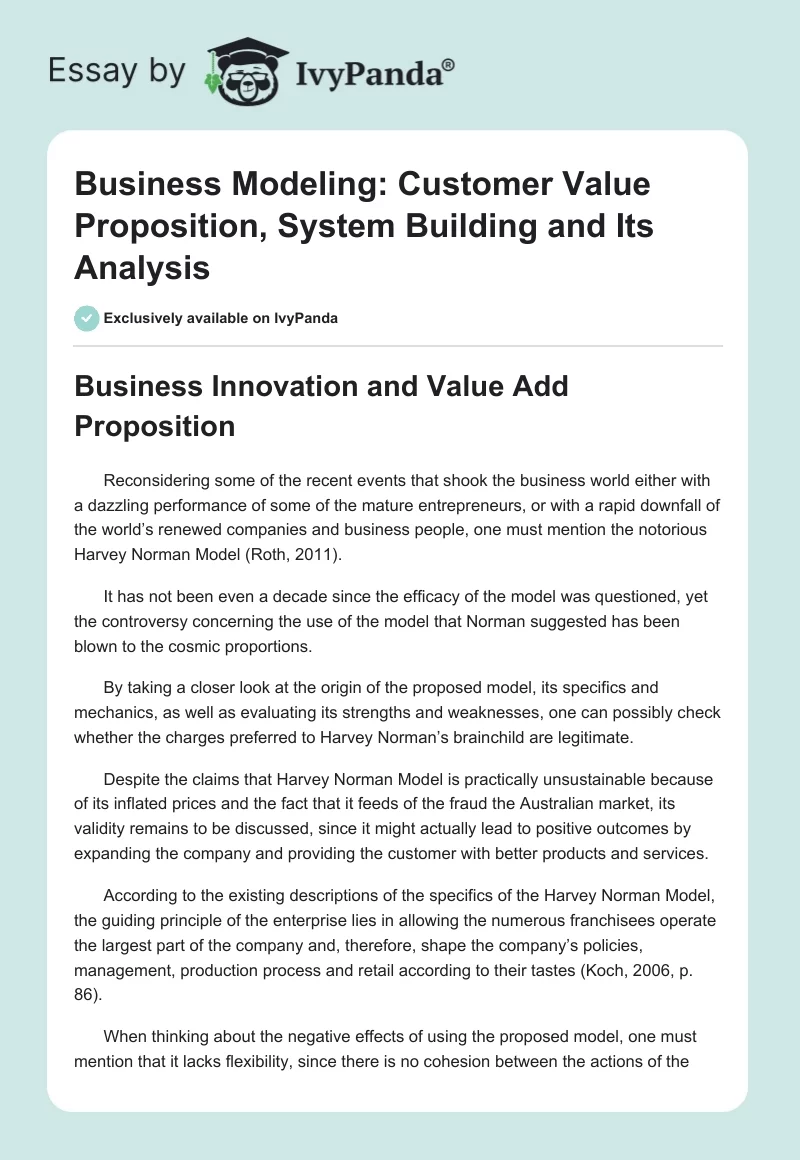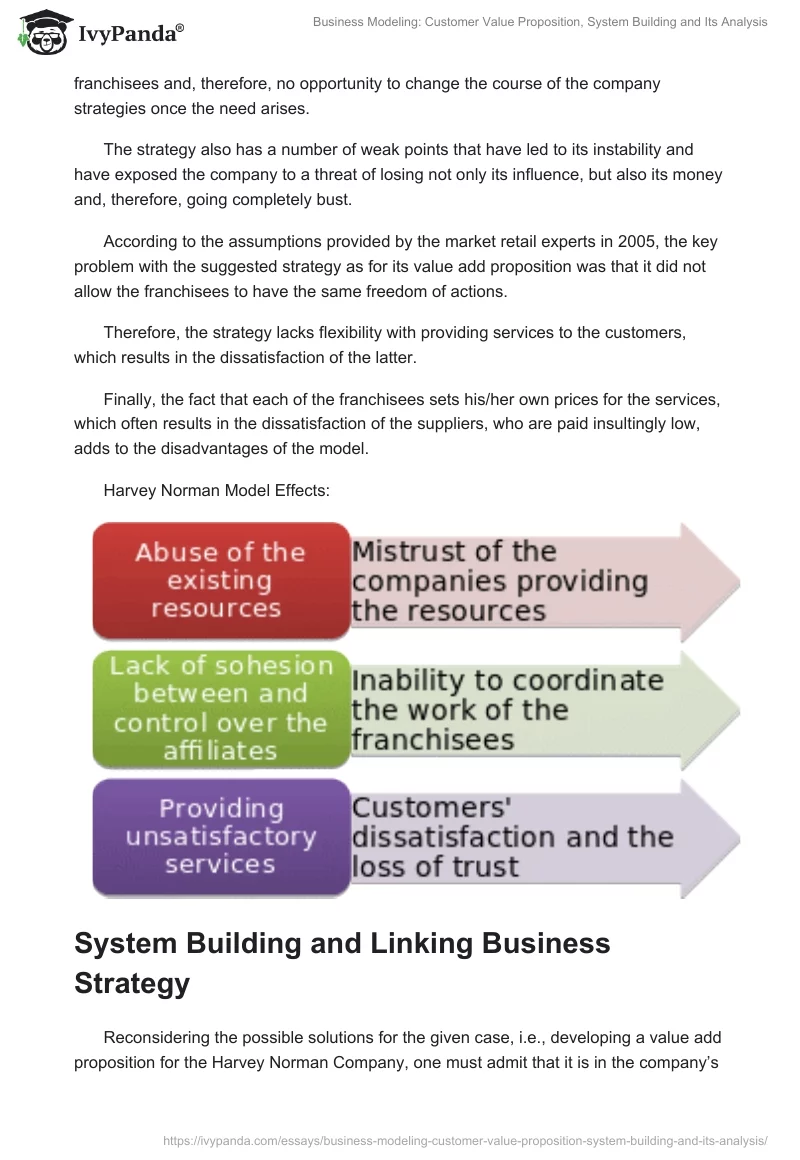Business Innovation and Value Add Proposition
Reconsidering some of the recent events that shook the business world either with a dazzling performance of some of the mature entrepreneurs, or with a rapid downfall of the world’s renewed companies and business people, one must mention the notorious Harvey Norman Model (Roth, 2011).
It has not been even a decade since the efficacy of the model was questioned, yet the controversy concerning the use of the model that Norman suggested has been blown to the cosmic proportions.
By taking a closer look at the origin of the proposed model, its specifics and mechanics, as well as evaluating its strengths and weaknesses, one can possibly check whether the charges preferred to Harvey Norman’s brainchild are legitimate.
Despite the claims that Harvey Norman Model is practically unsustainable because of its inflated prices and the fact that it feeds of the fraud the Australian market, its validity remains to be discussed, since it might actually lead to positive outcomes by expanding the company and providing the customer with better products and services.
According to the existing descriptions of the specifics of the Harvey Norman Model, the guiding principle of the enterprise lies in allowing the numerous franchisees operate the largest part of the company and, therefore, shape the company’s policies, management, production process and retail according to their tastes (Koch, 2006, p. 86).
When thinking about the negative effects of using the proposed model, one must mention that it lacks flexibility, since there is no cohesion between the actions of the franchisees and, therefore, no opportunity to change the course of the company strategies once the need arises.
The strategy also has a number of weak points that have led to its instability and have exposed the company to a threat of losing not only its influence, but also its money and, therefore, going completely bust.
According to the assumptions provided by the market retail experts in 2005, the key problem with the suggested strategy as for its value add proposition was that it did not allow the franchisees to have the same freedom of actions.
Therefore, the strategy lacks flexibility with providing services to the customers, which results in the dissatisfaction of the latter.
Finally, the fact that each of the franchisees sets his/her own prices for the services, which often results in the dissatisfaction of the suppliers, who are paid insultingly low, adds to the disadvantages of the model.

System Building and Linking Business Strategy
Reconsidering the possible solutions for the given case, i.e., developing a value add proposition for the Harvey Norman Company, one must admit that it is in the company’s interest that its reputation should be restored and it should get back to providing the customers with high-quality services and goods.
The latter, however, becomes attainable once the company proves that its marketing strategy is efficient enough to attract more clientele (Chait, Ryan & Taylor, 2011, n. p.). However, when considering the existing options a bit closer, one will be able to come up with a solution for the Harvey Norman Company.

Therefore, it is clear that with the choice of a proper strategy, the company is likely to solve the existing complexities and return to its normal course. The above-mentioned plan implementation will require changes in the company knowledge management system and the policy on supply chain management (Leeman, 2010).
Therefore, it would be a good idea for the company to expand, which will require to adopt the Virtual Merchant Model (Targowski, 2003, p. 258). By incorporating the latest technologies to coordinate the work between the affiliates and promote to the customers, the Harvey Norman Company will be able to survive.
System Analysis Techniques and Tools
For the Virtual Merchant Model to be applied successfully and the changes to trigger the desired outcomes, it will be necessary to reinvent the perception of how the company is run and represent a new way of addressing the customers, obtaining the supplies and running the numerous affiliates, which are scattered all over the world (Buchan, 2013).
It is clear that the Harvey Norman Company is by far too big to incorporate the specifics of every single affiliate into the analysis (Kurby & Drury, 2012). However, it will be required to have the information concerning all the franchisees, their policies and strategies.
Therefore, it will be necessary to conduct an analysis of the company process in general, provide the description of the structure of each affiliate and make a list of the company’s greatest concerns (APAIS: Australian public affairs information service, 2000).
While the Harvey Norman franchise system should still remain the driving force behind the company’s retail strategy.
To evaluate the efficiency of the adopted approach, however, specific measurement tools, such as customer surveys (Kenneth & Salini, 2011), will be required. Therefore, it will be reasonable to use such a tool as the rich picture (Elliott, 2004, p. 190).

System Building and Process Modeling
As it has been stressed previously, the key concern of the Harvey Norman company is its declining reputation and the ways to save it from a permanent damnation by its once loyal customers.
The given achievement can be attained by improving the quality of the services, as well as honest policies in relationships with suppliers, in contrast to the one that the company used to pursue.
Therefore, the following steps must be undertaken to change the current deplorable state of the company and restore its once high rank among the rest of the enterprises:
- Introducing the Virtual Merchant Model;
- Creating an online information database;
- Developing a report that will help check the progress of every single affiliate;
- Creating a system of company progress measurement and the affiliates performance assessment.

All the affiliates of the Harvey Norman Company should be involved into the system evaluation and improvement process.
Once all the necessary steps have been taken, the company will be referred to as a decent enterprise with clear policy and services of high quality, while the issue with the Harvey Norman Franchise Model will be long forgotten.
Reference List
APAIS: Australian public affairs information service, 2000, National Library of Australia, Melbourne, AU.
Buchan, J, 2013, franchisees as consumers: benchmarks, perspectives and consequences, Springer, Kensington, NSW.
Chait, R, Ryan, W P, & Taylor, B E, 2011, Governance as leadership: retaining the work of nonprofit boards. Web.
Elliott, G, 2004, Global business information technology: an integrated system approach, Pearson Education Ltd., Harlow, UK.
Kenneth, R & Salini, K, 2011, Modern analysis of customer surveys: with applications using R, Wiley, New York, NY.
Koch, D, 2006, Kochie’s guide to keeping it real, Murdoch Books, St. Leonard, NSW.
Kurby, J & Drury, B, 2012, Investing for dummies, John Wiley & Sons, New York, NY.
Leeman, J J A, 2010, Supply chain management: fast, flexible supply chains in manufacturing and retailing, Books on Demand, Dusseldorf, DE.
Roth, M, 2011, Top stocks 2012: a sharebuyer’s guide to leading Australian companies, Joh Wiley & Sons, New York, NY.
Targowski, A, 2003, Electronic enterprise: strategy and architecture, IGI, Hershey, PA.


